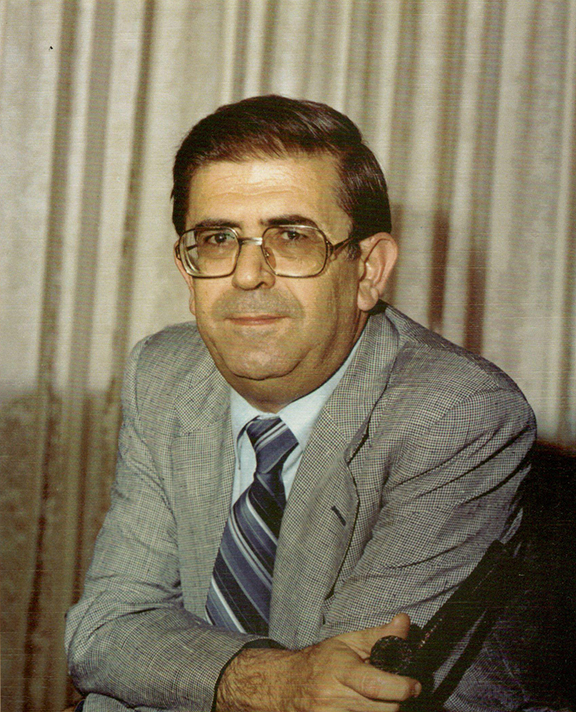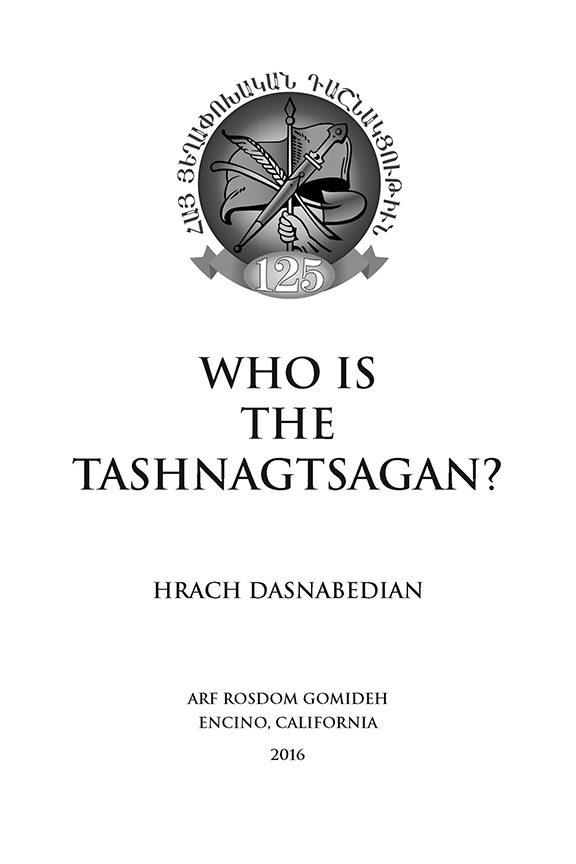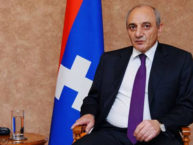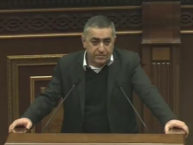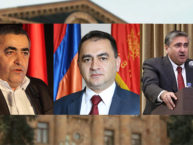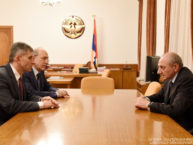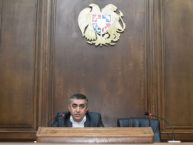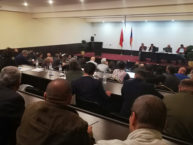(asbarez.com) EDITOR’S NOTE: The ARF-D Rosdom Gomideh of the San Fernando Valley West initiated the translation of Dasnabedian’s book “Who is The Tashnagtsagan” on the occasion of the ARF-D’s 125th anniversary, an excerpt from which is presented below. This project was sponsored by The publication of this book, Mr. and Mrs. Hovsep and Rita Bchakjian.
By HRACH DASNABEDIAN
Translated by ISHKHAN JINBASHIAN
Chapter 3: The Tashnagtsagan Moral Archetype
Defining the third and last attribute of the Tashnagtsagan is more complex than the previous two. In defining the Tashnagtsagan as a party member, we focused on the importance of adhering to the essential requirements of Organizational Rules. In describing the Tashnagtsagan as a person of conviction, we focused on the significance of the ARF Program, with its ideological preamble and system of political propositions, and the unique work method through which the Tashnagtsagan strives to help make them a reality. As for defining what constitutes the ideal moral character of the Tashnagtsagan, we don’t have written guidelines, but rather real-life examples that have been provided to us through chronicles of events and the memoirs of Tashnagtsagan activists.
The definition of the model Tashnagtsagan, especially with regard to moral attributes, is unwritten. There are no regulatory documents that determine the ideal temperament and character traits of a Tashnagtsagan. Therefore, inevitably, their definition is subjective, and, to some extent, sentimental in nature. Yet this statement cannot negate the existence of a uniquely Tashnagtsagan moral archetype. The Tashnagtsagan temperament and Tashnagtsaganness (դաշնակցականութիւն) are not mere words designed to boost our egos as party members, but rather realities that are as familiar to us as to our enemies and political opponents.
We already saw the manifestation of those realities in the distinct work method and operational style of the Tashnagtsagan. But the concepts of the Tashnagtsagan temperament and Tashnagtsaganness are much more complex, much richer and multilayered in their substance; they are inspiring and can create a dynamic atmosphere; they are enthralling, command respect and reverence, and foster communal thinking and a shared attitude. These concepts are present everywhere among Tashnagtsagan individuals and circles, as genuine and real as the objectivity of organizational rules and the Tashnagtsutyun’s world of ideals. The Tashnagtsagan temperament and Tashnagtsaganness are perhaps the most important qualities that illustrate the essence of the Tashnagtsutyun.
Having a distinct ideological worldview, pursuing a distinct set of goals, and operating by a distinct set of organizational rules — in other words, having a Program and By-laws — are qualities shared by all organized entities, including political parties. Yet rare are those organizations whose far-reaching revolutionary work and uncompromising and total dedication to an ideal have shaped a collective temperament, a unique organizational character, and an inspiring popular atmosphere. The Armenian Revolutionary Federation is among those very few organizations, and the only such organization in our national reality. Thanks to its archetypal character, thanks to Tashnagtsaganness, the ARF stands apart particularly from other Armenian political parties, in being a cohesive totality of individuals who are endowed with a unique set of moral attributes and beliefs, and who share a number of distinct character traits.
The Tashnagtsagan moral ideal, the Tashnagtsagan temperament and character, are tradition and legacy. They are the perpetuation of the archetype that was shaped by countless thousands of selfless followers, generation after generation, who were inspired by the pioneering luminaries of the Tashnagtsutyun. That archetype was forged during the first 25 or 30 years of the organization’s history. The moral edifice of the Tashnagtsutyun has risen with every martyrdom, every eloquent example of total and uncompromising self-dedication, every act of soaring heroism. Accordingly, there has emerged an accumulation of immeasurable historic achievement and moral excellence, as a lasting and indestructible source of inspiration, and as a sacred legacy that has shaped the character of successive generations of Tashnagtsagans.
Let us now enumerate the fundamental traits which comprise the Tashnagtsagan moral archetype. The history of the Tashnagtsutyun in general, and Roupen’s Hay Heghapokhagani mu Hishadagneru (The Memoirs of an Armenian Revolutionary) in particular, are inexhaustible sources of examples which eloquently illustrate the various attributes of the Tashnagtsagan character.
***
Idealism itself, which in the case of the Tashnagtsagan is complemented by the necessary components of activism and dynamism, is a crucial organizational attribute. In fact, the ideological essence of the Tashnagtsagan is the fundamental starting point for the various traits which define his or her moral persona. It would be all but futile to look for such traits in the character of a materialistic or egotistical person. It is idealism that fills people with boundless faith in a shared goal, as well as total and unconditional dedication, determination, and courage in its pursuit. It is idealism that can transform people into genuine heroes and devoted activists. It ennobles them, fires their imagination, and motivates them to soar above the ordinary and yearn to engage in acts of selflessness.
We have already discussed at length the attributes of activism and dynamism which stem from the idealism of the Tashnagtsagan, and which have engendered a unique work style defined by faith, determination, and uncompromising dedication. For an ideology-driven and ferociously persistent political party such as the Tashnagtsutyun, those attributes are part and parcel of its essence — a powerful legacy of the temperament, self-dedication, and work style of the organization’s founders and their immediate disciples. The likes of Hovhannes Yusufian, Bedo, Kalusd Aloyan, Arapo, Nigol-Tuman, and Vartan — to name only a few names from the noble elite of our revolution’s devotees — gave birth to our organization’s activism, dynamism, and potency. But it was Rosdom, the unrivaled master of revolutionary ACTION, who became the supreme forger of the familiar Tashnagtsagan methodology and operational style. To Rosdom, there were no primary or secondary duties. He served as not only a supreme leader and representative of the Bureau, but also, whenever needed, as a typesetter, bomb maker, or ammunition transporter. Rosdom was always there, wherever work and struggle were needed — whether in the Caucasus, Persia (Iran?), Geneva, Bulgaria, Garin, Constantinople, Van, or Baku — and his name is associated with many of the military, organizational, special-operations, ideological, public-awareness, and diplomatic activities of the first 30 years of our organization. “If the Tashnagtsutyun were to spend so much time on talking, it wouldn’t be able to do any work.”(1) These famous words, uttered by Rosdom in reply to Russian revolutionaries, are as characteristic of himself as the organization which he helped build. Also entirely characteristic of Rosdom and the Tashnagstutyun is the fact that when the Armenian-Tatar (Armenian-Azeri) War erupted, some members of the ARF Western Bureau left Geneva and their work at Troshag to join the fierce fighting in the Caucasus, at the cost of being severely criticized by the Fourth ARF World Congress.(2) Thus, to Rosdom and his like-minded comrades, what mattered was the actual struggle for national liberation. As for meetings and the day-to-day administration of the party, these became secondary when war was raging. As far as Rosdom and other activists and leaders were concerned, the flesh-and-blood waging of the liberation struggle came before everything else.
If indomitable faith in and total self-dedication to the goals of the organization became core Tashnagtsagan attributes, we must once again seek their source in the ideology, selfless devotion, and uncompromising self-sacrifice of our supreme leaders. In terms of forging tradition and preparing entire generations in the crucible of revolution, no amount of instructional books and fiery speeches can yield the result that can be achieved through a single personal example. And for the Tashnagtsagan, there has never been a shortage of personal examples associated with the organization’s leaders and warriors.
Krisdapor, the incomparable mentor, not only led the special committee tasked with organizing the assassination of the Sultan and the Izmir plots, but personally carried out numerous operations. Among these were the bomb-making experimentations in Sophia, during which Krisdapor, one of the founders of the Tashnagtsutyun and its supreme authority, lost his life. In the wake of his death and later still, many criticized Krisdapor’s participation — or the fact that the Third ARF World Congress had approved his participation — in such a dangerous operation. They had a good point, considering the high price which the operation had exacted. But we must also bear in mind that the forging of a tradition and atmosphere, and the revolutionary and moral character of the masses, does not come cheap. The magnificent moral edifice of the Tashnagtsutyun rests on the solid foundations of the self-sacrifice and willing martyrdom of the likes of Krisdapor.
The history of the Tashnagtsutyun is replete with such acts of selfless heroism. Hrayr, who was an Executive Committee member and embodied the spirit of the Tashnagtsutyun across the entire Turan Plateau, personally participated in the Sasun Uprising and was martyred on its frontlines. Sbaghanats Magar’s self-sacrifice and martyrdom at the Battle of Petar(3); the tragic fate of Maro and Garo (Arisdages Zorian)(4); the martyrdom of Torkom, Gaydzag-Vagharshag, and Yergat during their attempt to rush to the aid of Sasun’s rebel forces; the deaths of Yeprem, Keri, and, later, Sepasdatsi Murad, all three of whom, despite being commanders, fought alongside their soldiers on the frontlines; and numerous other examples, each more heroic than the other, serve to demonstrate the foundations which anchor the Tashnagtsagan’s spirit of sacrifice, selflessness, and utter dedication to the Ideal, the Work, and the revolutionary struggle.
Yet it would not be fair to view the physical martyrdom of leaders in the line of duty as the ultimate benchmark of service. It would not be fair to forget all those numerous comrades — people like Gugunyan, Markar Varjabed, Aram Aramian, and Vartkes — who for long years languished in Russian or Turkish prisons, slowly being martyred in inhumane conditions, and, in some cases, waiting to be hanged. Neither would it be fair to forget all those true believers — such as Hovsep Arghutian, Shahrigian, Hamo Janpoladian, Armen-Garo, Rupen, Tro, and Hrach — who left behind their families, the comforts of their homes, or their university lives in European cities to dedicate themselves unwaveringly to revolutionary work… and the legions of the Tashnagtsutyun’s activists, teachers, advocates, and intellectuals, who set aside life’s pleasures and instead opted for the most supreme of pleasures — the joy of serving one’s nation — and who served the Ideal loyally and with unwavering devotion, at the cost of unrelenting privations, hunger, and police persecution. Finally, when considering these extraordinary activists, how can we fail to give special mention to Zavarian, the genuine embodiment of the Tashnagtsagan spirit and the “worldly saint” of modern Armenian history?
Every Tashnagtsagan knows that to this day Simon Zavarian remains a standard for revolutionary and moral excellence. Often, when faced with a complicated issue in the course of our organizational or public work, we secretly ask ourselves, “What would Zavarian have done?” Indeed, Zavarian’s idealism, dedication, impeccable morals, integrity in intellectual and material matters alike, extreme diligence with regard to managing the organization’s finances, and, last but not least, modesty and humility have become touchstones and traditions for the Tashnagtsutyun and Tashnagtsagans. Zavarian did not fall in battle. He was never involved in the execution of a dangerous plot. But his entire life was a magnificent example of uncompromising dedication, ceaseless work, ideological and moral fortitude, modesty, and humility. In order not to cause even the least amount of financial burden to the party, Zavarian, the leader of the masses, traveled from village to village on foot, or took teaching jobs in Constantinople, at considerable cost to his health. He also kicked hoodlums and frauds out of the Tashnagtsutyun, but was always as tough and demanding toward himself as toward others.
Many of the articles of the ARF Program as well as decisions taken by various ARF World Congresses carry Zavarian’s imprint. “Based on past experience, the Tashnagtsutyun is convinced that as far as revolutionary activities are concerned, there can be no issues of rights and demands, but only issues of MORAL OBLIGATION and FULFILLMENT,” states the initial ARF Program, in the section titled “Organization.”(5) Clearly, a political party for which such a moral tenet serves as a fundamental structural and methodological starting point could be created only by the likes of Zavarian and in turn nurture devotees like himself. That tenet is the foundation stone of every Tashnagtsagan’s dedication and uncompromising willingness for self-sacrifice.
Furthermore, the below resolution, as proposed by Zavarian and summarized in Mikayel Varantian’s H. H. Tashnagtsutyan Badmutyun, would bring honor to any revolutionary organization: “Whereas protecting people’s livelihoods is among our fundamental objectives, and that unemployment can lead people to immorality as well as petty and unscrupulous means of making a living, which can hurt the Organization’s reputation, the Meeting resolved the following: a) that every Tashnagtsagan must be endowed with moral and revolutionary qualities worthy of an upstanding individual; b) that every Tashnagtsagan, wherever he or she may be, must spread the ideals of the organization through advocacy and especially tangible work; and c) that every soldier, and revolutionaries of every rank, whether abroad or in Armenia, must earn an honest living whenever not fully engaged in the service of the Organization.”(6) There is no doubt that the Tashnagtsagan tradition of expecting absolute integrity, incorruptibility, honesty, meticulousness, and diligence with regard to organizational and public activities alike is a virtue fostered by Zavarian.
Another Zavarian-inspired attribute, modesty, has stood out as a fundamental virtue of guiding lights such as Nigol-Tuman, the incomparable forger of warriors, and the Tashnagtsagan fedayees who are modern Armenian history’s army of knights. There are other quintessentially Tashnagtsagan attributes still, including camaraderie and mutual respect, affection, and devotion, which were fostered by Zavarian, Krisdapor, and Rosdom and transmitted to us through the likes of Aram, Rupen, Ishkhan, Kevork Chavush, Sbaghanats Magar, Murad, and legions of other figures, famous or not. The history of the Tashnagtsutyun abounds with testaments to the fellowship and mutual respect that existed between such individuals, despite their differences of opinion.(7) Given the moral principles of the Tashnagtsutyun, whereby comrades-in-arms dedicated to a powerful ideal are prepared to make the ultimate sacrifice at any given moment, no other type of revolutionary army would be conceivable.
***
The quintessential Tashnagtsagan attributes, which exude nobleness and chivalry, were not new to the Armenian people. If we accept that the Armenian revolution was a consequence of the renaissance of the Armenian people; that the Armenian liberation struggle, after the darkness of some six centuries of slavery, was a result of the rebirth of our freedom-yearning ideology and fighting spirit, then it follows that what reawakened parallel to the Tashnagtsagan cause, aspirations, and struggle were all the moral traits which once defined Armenia’s nobility, its generals and soldiers, princes and knights. Here’s what Khrimian Hayrig wrote, as early as in 1896, in a pontifical edict addressed to the Armenian population of Vasburagan: “The Tashnagtsutyun is the new Armenian knighthood. Every one of its warriors, fighting on the frontlines of Vasburagan and elsewhere, is a knight in shining armor.”(8)
It must be stressed, of course, that the spirit of nobleness and chivalry is complemented by a national ideal and utmost dedication to the cause. The rekindling of the noble legacy of the Armenian nation was achieved by the Tashnagtsutyun and Tashnagtsaganness. In turn the Tashnagtsutyun and Tashnagtsaganness gave birth to the new army for the liberation of Armenia.
Courage and audacity: these are the attributes which complete the moral archetype of the new Armenian freedom fighter, the Tashnagtsagan. Without these two attributes, even ideological dedication would be insufficient to explain the greatness of leaders such as Krisdapor, Magar, Yeprem, Keri, Murad, or Aram. Without the fundamental character traits of courage and audacity, it would be impossible to explain the self-sacrifice of all of our revolution’s secret agents, underground activists, and advocates. In particular, it would be impossible to explain the marvelous re-emergence of the Armenian warrior: the fedayee–our modern-day knight, the volunteer, and the special-operations agent. In other word the Tashnagtsagan soldier.
It would be impossible to decide which specific Tashnagtsagan figure or event is the fountainhead of the organization’s defining attributes. That’s because the entire history of the Tashnagtsutyun’s first 35 years consists of an unbroken series of individual and group exploits and acts of heroism, gleaming with the golden names of freedom fighters such as Arapo, Papken Suni, Vazken, Kurken, Serop, Antranig, Bedros Semerjian, Kevork Chavush, Kaleh, Shenugi Manug, Petara Manug, Hamazasb, Tehlirian, and Shirakian, among hundreds of others. The Tashnagtsutyun’s legendary battles and special operations, including those of Banque Ottomane (Ottoman Bank), Samatia, Khanasor, Terik, Gurubash, Khasdur, Arakelots Vank, Sasun, Mosun, Zor, Sulukh, Petar, Akhtamar, Askeran, Zankezur, Baku, Vasburagan, Jebel Musa, Urfa, Shabin-Karahisar, Sartarabad, Gharakilise, Pash-Abaran, and numerous other campaigns, big or small, each more heroic than the other, have had a decisive role in fostering the fighting spirit and bravery of the Tashnagtsagan.
Inspiring, riveting, and instructive, those battles and operations are an inexhaustible historical legacy as well as a revolutionary and moral tradition. They enrich the inner world of the Tashnagtsagan, often keeping it under pressure, keeping it ready to erupt when the time and circumstances become ripe for resuming the Armenian liberation struggle — and when the Tashnagtsutyun decides to do so. The timing of such a resumption must be perfect, because ill-timed aggression, no matter how impassioned and daring, may result in an unfavorable and even harmful outcome if it’s not undertaken as the collective goal of the organization, and if it’s not planned flawlessly. As we saw, any organized entity entails, first and foremost, conformity and order, and the compliance of all members with the collective decisions of the organization. Therefore we arrive at the Tashnagtsagan’s last but certainly not least important attribute, discipline.
Perhaps it would seem strange to revisit the subject of discipline here, after having discussed it in a previous chapter.(9) But we think it’s entirely warranted, given the fact that discipline, apart from being a core Tashnagtsagan characteristic today, has always been part and parcel of the ideological and moral fiber of Tashnagtsaganness. In fact, the Tashnagtsagan brand of discipline has often and rightfully been referred to as “iron discipline.” To the Tashnagtsagan, being fully versed in the ideology of the party and its unassailable revolutionary and moral principles, abiding by the decisions of the organization’s governing bodies, believing in the goals of the Tashnagtsutyun, and having the resolve to do one’s utmost to help implement the organization’s objectives are not merely a matter of complying by rules which apply in only certain situations, but rather a way of life, existential meaning, something of a second nature. Therefore discipline, along with our other operational principles, is an enduring source of our organization’s strength.
When, as ordered by Serop, Kevork killed his own uncle for having violated the honor of an Armenian family; when the unfortunate Hovan submitted to the ruthless verdict of a fedayee council to stab the woman who had “deceived” him; when the white-haired prince of Sasun, Sbaghanats Magar, obeyed an order by the young Rupen (who was a novice representative of the Tashnagtsutyun at that time) to disarm himself and his comrades-in-arms (a punishment that to the fedayee was worse than death itself); when great warriors like Tashnagtsagan Khecho actually knelt to kiss the edicts which bore the red seal of the ARF; or when, after shooting Jivanshir and safely leaving the scene, Misak Torlakian returned to the spot, and, at the risk of being arrested, fired several more shots into his target, so as to complete his mission exactly as he had been instructed by his superiors… these men did something more than obeying rules and following orders. They were, in fact, forging the indomitable, unwavering discipline of the Tashnagtsagan armies of their day and those of subsequent generations, bequeathing to us the unshakable resolve of infallibly and fully carrying out the decisions of the party. These men were laying the foundations of one of the hallmarks of the Tashnagtsutyun.
***
Idealism complemented by total dedication. Activism, energy, fervor, courage. Tenacity and unremitting willingness for self-sacrifice on the path to the realization of collective goals. Disinterest with regard to personal gain, fair-mindedness, integrity, modesty, and mutual love and affection between comrades. And a perception of discipline as not merely another rule to follow, but a vital matter of moral commitment. These are the essential attributes of the Tashnagtsagan’s moral character, and what constitute Tashnagtsaganness. These are the traditions bequeathed to us by the generations that rose up, fought hard, and were martyred as they restored our nation and homeland after centuries of bondage. These — the noblest of Armenian national values which were reborn with the liberation struggle — are our cherished legacy.
Without a complete espousal of the Tashnagtsagan moral character, being proficient in the rules and goals of the organization would not be enough to forge a genuine Tashnagtsagan. The more a young person entering the ranks of the Tashnagtsutyun strives to embody the moral archetype of the Tashnagtsutyun and embraces its atmosphere of activism, the better Tashnagtsagan he or she will go on to become.
The aforementioned revolutionary and moral precepts and character traits, as well as the atmosphere of activism they foster, are of fundamental importance to the Tashnagtsutyun. Without them, the Tashnagtsutyun would have been just another political party. This is why the very first article of the ARF By-laws emphasizes good moral character as a prerequisite for being admitted to the ranks of the organization. A person who is lacking in core moral values will not be able to comprehend and embody the Tashnagtsutyun’s beautiful yet complex essence.
It’s completely understandable that after being admitted to the ranks of the Tashnagtsutyun, many individuals will prove lacking in the necessary moral fiber, and, failing to connect with the Tashnagtsagan environment and finding its stringent moral expectations and atmosphere to be too heavy for them, will eventually leave the organization.
Yet Tashnagtsaganness, the archetypal traits of the Tashnagtsagan character, are daily realities. An indication of this is that often, when we’re outside our circle of comrades, we can immediately tell from a stranger’s manner of expression, comportment, and stance toward any public or personal issue that he or she is a Tashnagtsagan, and at once we feel a shared sense of kinship.
Certainly it would not be fair to conclude from all this that the writer of these lines believes every Tashnagtsagan is perfect, a “worldly saint” similar to Zavarian, endowed with all the moral attributes of Tashnagtsaganness. It would be impossible, and inconceivable, to claim that there have not been or there aren’t individuals in our organization who lack many of the attributes of Tashnagtsaganness, individuals who in fact have shown an aversion to those attributes — that is to say, they might be profit-seekers, cowards, frauds, or egotists. But we have every right to insist, and ample proof to show, that such individuals can remain in the Tashnagtsutyun only temporarily, that sooner or later and naturally they will either leave the organization or be ousted. This fact is known to every Tashnagtsagan — and, in fact, every anti-Tashnagtsagan who claims otherwise.
It is also extremely significant that the recent translation of the late-19th and early-20th-century archives of the Paris branch of the Okhrana, the Russian Imperial Police, does not include the name of a single prominent Tashnagtsagan to have agreed to spy on his comrades for the Tsarist secret police, whereas so many high-profile non-Tashnagtsagan figures had worked for it.(10)
Young comrades, no one among us can be at once as idealistic as Zavarian, as resolutely dedicated as Krisdapor, as active and dynamic as Rosdom, as intrepid as Murad, as daring as Kevork, as modest as Nigol-Tuman, as brave and noble as our fedayees, and as committed and unselfish as our early activists. Tashnagtsaganness, with its various attributes, is the collective legacy of these luminaries, the sum total of all their extraordinary character traits. It is a spirit, an atmosphere, which we must keep alive as a source of inspiration. It is a unique moral profile which we must strive to embody gradually, through knowledge and incorruptible service. And in order to be worthy of the difficult calling of the total and genuine Tashnagtsagan, in the service of the Tashnagtsutyun and its goals, in which we believe, we must, every day, strive to become better Tashnagtsagans.
(1) See V. Navasartian, Kaghaparneri Vokin (The Spirit of the Ideal), pages 175-176; and page [TO BE DETERMINED], fourth footnote, in this volume.
(2) See Nyuter H. H. Tashnagtsutyan Badmutyan Hamar (Topics for the History of the A. R. Federation), Volume 3, Minutes of the 16th and 17th Sessions of the Fourth ARF World Congress, pages 36-41.
(3) See Rupen, Hay Heghapokhagani mu Hishadagneru (The Memoirs of an Armenian Revolutionary), Volume 4, third edition, Chapter 6, pages 201-213.
(4) See Hushabadum H. H. Tashnagtsutyan (A Memoir of the A. R. Federation), pages 375-381.
(5) See “Dzrakir H. H. Tashnagtsutyan,” (“The Program of the A. R. Federation”), Nyuter H. H. Tashnagtsutyan Badmutyan Hamar (Topics for the History of the A. R. Federation), Volume 2, page 15.
(6) See Mikayel Varantian, H. H. Tashnagtsutyan Badmutyun (History of the A. R. Federation), pages 104-106. See Zavarian’s complete text in Nyuter H. H. Tashnagtsutyan Badmutyan Hamar (Topics for the History of the A. R. Federation), Volume 2, page 247.
(7) Rupen, Hay Heghapokhagani mu Hishadagneru (The Memoirs of an Armenian Revolutionary), Volume 2, third edition, Chapter 7, pages 384-406. See, in particular, the clash of ideas between Rupen and Ishkhan and the resolution of the Van Regional Meeting.
(8) Hayg Ajemian, Hayots Hayrig (Hayrig of the Armenians), Volume 1, page 700.
(9) See pages [TO BE DETERMINED: REFER TO THE PAGES OF CHAPTER 1, ITEM b]
(10) In 1981, A. Amurian translated the archives of the Paris branch of the Okhrana into Armenian. The project was initiated by the ARF Bureau. The original Okhrana archives are kept at the Hoover Institution Library and Archives, in San Francisco. For more information on the archives of the Paris branch of the Okhrana, see Comrade A. Amurian’s articles published in Aztag Weekly during the early 1980s.

